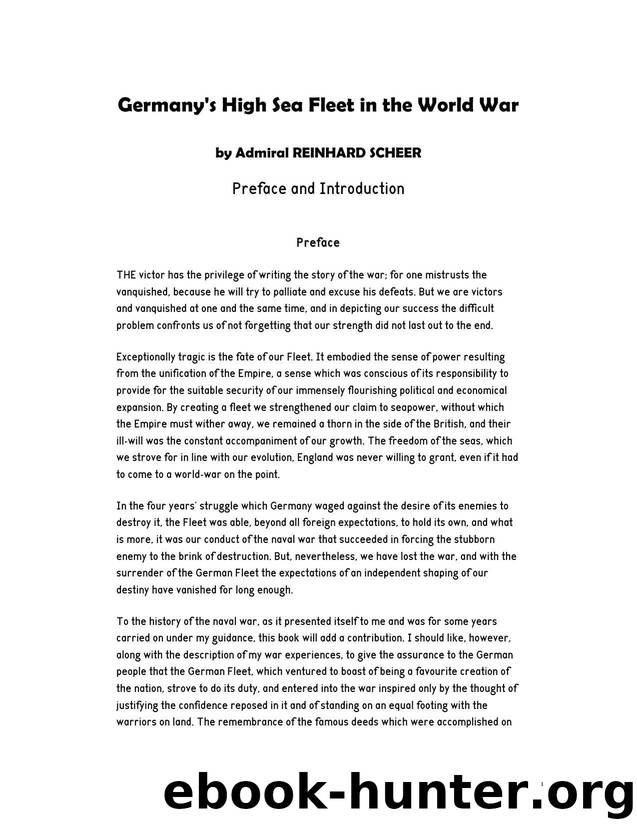Germany's high sea fleet in the World War by Reinhard Scheer

Author:Reinhard Scheer
Format: mobi, epub
Tags: Europe, World War I, World War II, Naval, 1914-1918, Germany, Military, World War, History
Publisher: Cassell and Company, ltd.
Published: 1920-12-14T16:00:00+00:00
159
fight when our ships were already damaged.
The sinking of the Pommern had unfortunately proved that this class of ship could not be risked in heavy fighting, owing to their being insufficiently protected against the danger of being sunk. The tactics of the British made it unlikely that our Squadron II would be able to take part in another big battle, on account of its artillery and its old type of torpedo, which had a range of less than 6,000 metres. I did not, therefore, take these ships with me, but assigned to them the duty of guarding the German Bight in the absence of the Fleet. When the Fleet went out in this way, a torpedo flotilla was sent on ahead to the probable vicinity of the guard-line of English submarines, the object being to keep the latter under water and so prevent them from giving too early a warning of our approach.
On October 10 the Fleet advanced according to this plan to the centre of the North Sea, but the torpedo-boats were unable to go as far afield as had been arranged, owing to adverse weather conditions. There was no encounter with the enemy. The resumption of the U-boat campaign against commerce, which was to begin early in October, had to be supported as far as possible, even though it was little to the taste of the Navy, and had also been adversely commented upon by Admiral von Schröder, the head of the Naval Corps in Flanders.
Download
Germany's high sea fleet in the World War by Reinhard Scheer.epub
This site does not store any files on its server. We only index and link to content provided by other sites. Please contact the content providers to delete copyright contents if any and email us, we'll remove relevant links or contents immediately.
Fanny Burney by Claire Harman(26259)
Empire of the Sikhs by Patwant Singh(22775)
Out of India by Michael Foss(16695)
Leonardo da Vinci by Walter Isaacson(12819)
Small Great Things by Jodi Picoult(6694)
The Six Wives Of Henry VIII (WOMEN IN HISTORY) by Fraser Antonia(5245)
The Wind in My Hair by Masih Alinejad(4853)
The Crown by Robert Lacey(4579)
The Lonely City by Olivia Laing(4577)
A Higher Loyalty: Truth, Lies, and Leadership by James Comey(4567)
The Iron Duke by The Iron Duke(4127)
Millionaire: The Philanderer, Gambler, and Duelist Who Invented Modern Finance by Janet Gleeson(4117)
Papillon (English) by Henri Charrière(3924)
Sticky Fingers by Joe Hagan(3916)
Joan of Arc by Mary Gordon(3797)
Alive: The Story of the Andes Survivors by Piers Paul Read(3743)
Stalin by Stephen Kotkin(3731)
Aleister Crowley: The Biography by Tobias Churton(3435)
Ants Among Elephants by Sujatha Gidla(3282)
